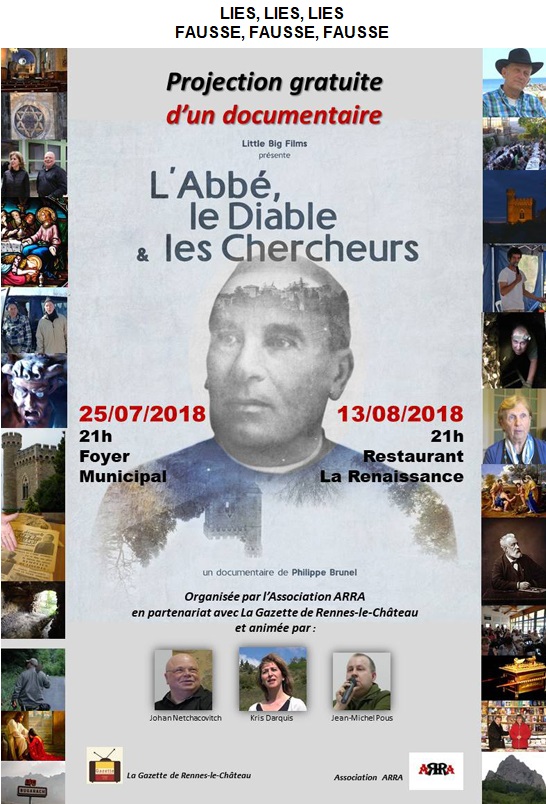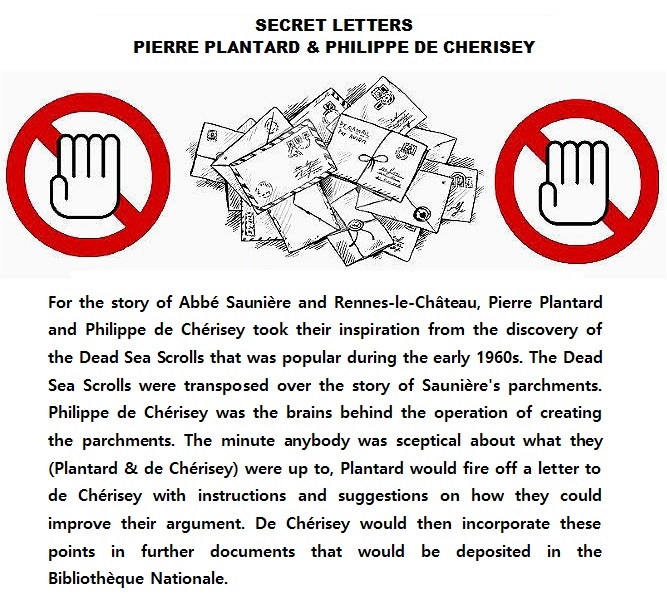Philippe Brunel – LIES, LIES, LIES of Rennes-le-Château
“L'abbé, le diable et les chercheurs”
Paul Smith
1 July 2018
Put Online At 13:15 PM GMT
The Tourist Attraction gimmicks of Rennes-le-Château continue to flourish into the 21st Century.
Philippe Brunel's name can be added to the latest chapter of events. He is a documentary maker who has turned his attention to Rennes-le-Château.

The LIES of Rennes-le-Château began during the mid-1950s with Noël Corbu, who later teamed-up with Robert Charroux; followed by scandalous charlatans Pierre Plantard and Philippe de Chérisey, who later teamed-up with Gérard de Sède. The next big step was Henry Lincoln (who systematically ignored René Descadeillas's study of the historical life of Abbé Bérenger Saunière) – who later teamed-up with Michael Baigent and Richard Leigh – inventing the air-drawn fabric of the Jesus Bloodline.
The subject matter of the alleged mystery of Rennes-le-Château is a notorious LIE that has lasted for 64 years. Nobody in the past 64 years has produced any evidence that any mystery has existed in the village.
Only self-deluded believers and authors keep the subject matter going. The village is a massive tourist attraction and its Municipal Council keeps the LIE going.
Turn back the clock to the lifetime of Abbé Bérenger Saunière. The Abbé was accused of trafficking in masses and had to attend three ecclesiastical trials 1910-1911. After being stripped of his priesthood, Saunière decided to sell his property through Banque Petitjean of Paris and move out of Rennes-le-Château, but he could not find a buyer for his religious property in a country that was quickly transforming into a secular society.
Saunière died in abject poverty in 1917, owing money to his greengrocer.
Abbé Bérenger Saunière refused to show his carnets at his trial, claiming that he had destroyed them (these account books show that Saunière obtained at least 250,000 francs from trafficking in masses).
Sauniére’s letter to the bishopric dated 8 April 1911 partly stated: “You are aware of Rome’s first decision. Does it refer anywhere to the keeping of accounts? Not at all”
Philippe Brunel needs to be told that much of the Rennes-le-Château “evidence” originates from Pierre Plantard and Philippe de Chérisey of the 1960s – some of it developed from the earlier 1950s fabrications of Noël Corbu (eg, dalle de coumesourde).
People's various alleged “memories” were undoubtedly inspired by Noël Corbu’s jinks of the 1950s and early 1960s. D. H. Rawcliffe coined the term “Retrospective Falsification” during the 1950s.
The subject matter of Rennes-le-Château amounts to nothing more than LIES, LIES, LIES.
It is sometimes claimed that it is no good to call people liars.
Noël Corbu was a good example of a liar. His 1956 claims in La Dépêche de Midi were one thing, his claims in his tape-recordings for his guests to his restaurant were another, and his 1962 radio show interview was another metamorphosis (not to mention Marina Grey's 1961 documentary, that revealed further accretions).
Nobody can deny that Pierre Plantard and Philippe de Chérisey were liars, since this was revealed in the changing course of their respective allegations found in the Priory of Sion Documents; and of course their admission that the “parchments” were invented for Gérard de Sède's 1967 book, L'Or de Rennes.
Pierre Plantard and Philippe de Chérisey wrote about their devious and nefarious scheming in 1960s correspondence to each other. Unfortunately, the correspondence between them cannot be published because the copyrights of the letters belong to their respective children, Thomas Plantard de Saint-Clair and Gaspard de Chérisey.
Finally, it must be acknowledged that the Abbé Bérenger Saunière himself was a liar and a crook – guilty of accepting more money than he was able to say masses for.

|

